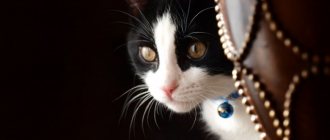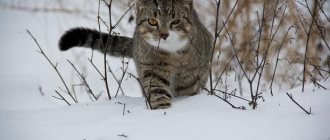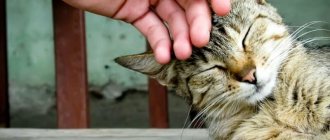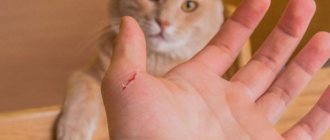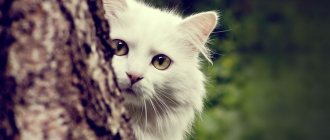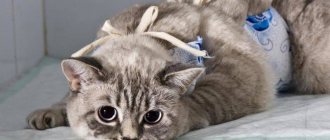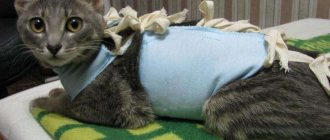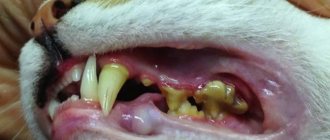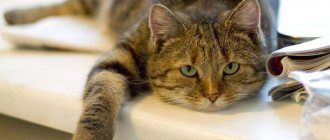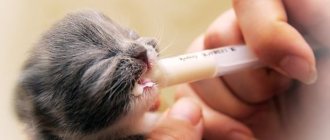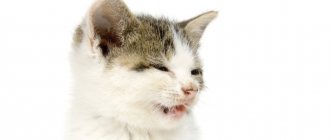The weight of a cat depends on age, gender, breed, and the presence of nutrients in the food. An adult yard cat weighs no more than 5 kg, but if the cat is Scottish, then its weight reaches 7 kg or more, a Maine Coon cat weighs up to 10 kg or more. If the cat is young, then its weight can change dramatically, increasing or decreasing depending on its lifestyle: the more active the animal, the faster it sheds the kilos it has gained. In the body of older cats, fat accumulates at a slower rate, so cats over 9 years old look thin. Below we will discuss why the cat is thin, and whether this is really dangerous for his body.
Signs of exhaustion
When wondering why a cat is thin, and whether this is normal, factors such as normal and painful thinness are taken into account. In the first case, we are talking about the weight standard that an animal of a particular breed must meet at a certain age. The second is about exhaustion. A cat that is too thin is most likely sick and requires long-term rehabilitation therapy, which can only be prescribed by a specialist.
Appearance standards for British breeds
Healthy cat diet
The owners themselves are often to blame for pets having weight problems. Often people overfeed their pets, leading to obesity, or, on the contrary, give them insufficient food. A common mistake breeders make is feeding unbalanced or low-quality food.
Fortunately, the problem of malnutrition can be easily eliminated at home by taking care of a healthy menu for your pet.
What to do if your cat is thin but eats well? It is necessary to include in her diet the products necessary for normal life. First of all, you need to remember that cats are carnivores and their menu should consist of 50% meat products. The pet should also drink well, so there should always be fresh, clean water in the bowl.
If the cat is thin, his diet must include::
- lean boiled meat (beef, chicken, turkey);
- vegetables (carrots, pumpkin, spinach);
- cereals (buckwheat, oatmeal, rice);
- liver (beef, chicken);
- dairy products (natural yoghurt, cottage cheese);
- boiled fatty fish (herring, sardine, mackerel, salmon).
Special vitamin complexes and dietary supplements will also help correct the situation. And if the cat eats ready-made food, then among the premium items there will definitely be a high-energy type that can solve the problem.
Proper nutrition is the key to the health of a pet . Balanced food, attentive attitude of the owner, timely contact with specialists will help the pet stay well-fed and live a happy cat life.
The weight of a cat depends on age, gender, breed, and the presence of nutrients in the food. An adult yard cat weighs no more than 5 kg, but if the cat is Scottish, then its weight reaches 7 kg or more, a Maine Coon cat weighs up to 10 kg or more. If the cat is young, then its weight can change dramatically, increasing or decreasing depending on its lifestyle: the more active the animal, the faster it sheds the kilos it has gained. In the body of older cats, fat accumulates at a slower rate, so cats over 9 years old look thin. Below we will discuss why the cat is thin, and whether this is really dangerous for his body.
Normal thinness
Why do cats sleep a lot: the main reasons and is it normal?
A cat's weight has a lot to do with its age and breed:
- a domestic mongrel cat at the age of 1 year weighs from 2.5 to 4.5 kg (naturally, the figures may differ, but usually not significantly);
- a purebred cat at 1 year weighs from 3.5 to 5 kg;
- a cat of the British breed, reaching one year of age, weighs up to 4.5-4.6 kg;
- A British cat normally weighs from 4.5 to 7 kg, provided it receives the right amount of food.
Each of the existing cat breeds has its own weight table, which all animal owners must follow.
In a healthy cat:
- it is easy to feel the ribs and spine, but they are not visible from the side;
- there is a small amount of fat in the abdomen, back and chest;
- the waist line is clearly visible;
- the stomach does not sag, it is almost non-existent.
A cat can lose weight or gain weight while feeding or bearing kittens, and a cat during the mating period. This kind of thinness is considered normal. Sometimes an animal suddenly loses weight after experiencing stress (moving, a trip to the veterinarian). And that's okay too. If the kitten’s parents were not large or purebred, then you should not expect that after 1-2 years the pet will turn into a fat lazy cat, as in the picture in the advertisement.
Outbred cats are smaller and lighter than their purebred counterparts and even those animals that appeared as a result of crossing a purebred pet with a barn cat. The kittens will still be larger than those that an ordinary yard cat gives birth to, and accordingly, they will also weigh more.
Genes help you stay in shape
After all, if a cat eats a lot, but is thin, it is very likely that this is a feature of its “constitution”. The standard for many breeds requires a cat to be slender - these are Siamese, Bengals, Abyssinians, Russian Blues and many others. If your pet is one of these, read the description of the breed. It is quite possible that in your case, “a thin cat that eats well” is the norm. “Nobles” are also slender, but with a good appetite, especially if they are not castrated or sterilized. Greater mobility and good metabolism help many mustachioed people stay in shape without limiting themselves to treats.
We hope that your cat is just like that – healthy and has a good appetite!
When is it time to sound the alarm?
The cat is drooling: the main causes and treatment options
Cats begin to worry about being thin if:
- the cat eats a lot and often, but does not gain weight, it is too light and small for its breed (thin cats do not gain weight);
- the spine can be traced visually (the ridge literally protrudes outward);
- the pelvic bones and ribs protrude, their movement is clearly noticeable when the cat moves;
- the cat’s breath smells unpleasant (obviously, the gastrointestinal tract is disrupted, the kidneys and liver are not functioning properly, plaque or caries may have formed on the teeth);
- there is no fat layer on the chest and back area, only bone;
- the cat does not show usual attention to toys, sleeps constantly;
- the animal has loose stools (if mucus, blood, or undigested parts of food are found in the stool, consult a doctor);
- yellowness or excessive pallor of the mucous membranes is observed, they become gray in color (most likely, weight loss is due to problems with the liver and kidneys);
- more fluid is released from the eyes, nose and mouth than usual, especially when an unpleasant odor appears, a change in the color of the animal’s tears and saliva;
- the temperature rises (hot nose, the cat is lethargic, to check the temperature it is enough to use a regular thermometer);
- the stomach is sunken, hard, tense.
The silhouette of an emaciated cat resembles an hourglass.
When the described signs appear, the animal is weighed (to do this, just place it in a bag and use a steelyard or in a cardboard box, cover the top with something and put it on a regular floor scale).
If the cat always eats well, but is very thin, weighs 1 kg or more less than it should, contact a veterinarian. It is first necessary to take weight measurements for several weeks in a row to make sure that there really is a reason for concern (cats are thin and do not gain weight for various reasons, but most often due to illness).
Mistakes while feeding
Experienced breeders and veterinarians note the following feeding errors that lead to weight loss in a cat:
- Small portions of food that do not meet the physiological needs of the animal. Some owners do not take into account the breed, age and gender of the animal when feeding.
- An unbalanced diet or its inconsistency with the pet’s needs. For example, chronic protein deficiency sooner or later leads to thinness.
- Feeding without taking into account the animal's taste preferences. Cats are great conservatives, especially when it comes to food. If your pet wants to eat dry food and refuses to eat natural food, then you should feed it with ready-made food.
- Incorrect placement of the food bowl. Close proximity to the toilet, placement in a noisy and walk-through room do not contribute to a good appetite.
For the basic principles of feeding cats, watch this video:
Knowing the numerous causes of weight loss in a pet, the owner will sound the alarm in time. After the veterinarian has ruled out infectious diseases and other serious pathologies in the pet, attention should be paid to proper nutrition of the animal.
Why doesn't a castrated cat get fat?
Dry nose in a cat: main causes and what it means
There is an opinion among owners of cats that have not yet been neutered that as soon as castration occurs, absolutely everything in the character, lifestyle and behavior of the animal will change. Cats become calm and even lazy, stop marking, and begin to quickly gain weight. In relation to probably 70-80% of castrated animals, this opinion is justified, since it is based on the knowledge that after the procedure the hormonal levels change, the cat’s metabolic processes slow down, which means it becomes less energetic. But this doesn't always happen.
Note! If the animal was neutered late, at 1.5-2 years, then there is a high probability that there will be no sudden changes, so the sight of a skinny cat should not be alarming.
The absence of changes in weight is also affected by proper feeding. So, if a cat consumed dry food before castration, then changing the food (switching to natural products) affects the weight (the cat gets fat). If the cat is fed according to the same scheme as before, then no changes occur.
Much also has to do with the breed. British cats immediately after castration begin to consume more food, their body weight quickly increases by 2-3 times. The body weight of a neutered yard cat remains unchanged. The procedure can affect this parameter, but, like with people, everything is individual, some pets cannot gain weight just because of castration, therefore, if the owner dreamed that he would have a fat and very lazy cat, he may have to be disappointed .
Change of feed
One of the reasons for weight loss in a cat is a change in food. This is due to the fact that the animal does not accept new food and because of this loses weight. This is especially noticeable when the owner suddenly tries to switch his pet from homemade food to dry food. If you want to change your animal's diet, then it should be done gradually.
If a cat’s weight loss is directly related to nutrition, then you need to choose food for the animal that it will eat with pleasure. When switching a cat to another food, you need to monitor its condition. If there are any deviations, she will need to be shown to a doctor. It is also worth monitoring weight gain while introducing new foods.
We suggest you read: Symptoms of common diseases of the toy terrier
Causes of exhaustion
Exhaustion, or cachexia, develops under the influence of exogenous (external) and endogenous (internal) factors.
Exogenous
Exogenous external causes of exhaustion include:
- lack of food (emaciation is observed in feral cats and animals that receive food from time to time);
- impaired swallowing functions (the cat has something stuck in its throat, the nasopharynx is inflamed due to an insect bite, under the influence of allergens);
- problems with teeth (inflammation in the oral cavity, caries, tartar - all this prevents the animal from eating its usual food).
Natural Cause of Thinness
An adult cat should receive at least 70 g of dry food per day. If the cat is nursing offspring or is sick, the norm is doubled. At the same time, there should always be only fresh food in the bowl, as many food manufacturers warn about.
Endogenous
Endogenous (internal) factors that provoke cachexia include diseases of a non-infectious and infectious nature. Cats lose weight due to the development of:
- oncological diseases;
- cardiovascular pathologies;
- diabetes mellitus;
- chronic infections (infectious peritonitis, immunodeficiency, leukemia).
Cachexia is caused by hormonal disorders, problems with the pancreas, dysfunction of the kidneys, liver, and pituitary gland.
Sometimes weight loss occurs due to:
- the occurrence of a stressful situation (if the cat is given into the wrong hands, often transported);
- bearing offspring and feeding kittens (nursing cats often become excessively thin, so that a thin cat does not become completely exhausted and gets sick, kittens are weaned as soon as they begin to feed on their own);
- vitamin deficiency (feed must be balanced, it is useful to give the cat additional vitamins);
- formation of hairballs in the stomach (from time to time pets are given special tablets to cough it up);
- infection of the pet’s body with helminths (parasites release dangerous toxins, weaken the cat, their activity over time leads to physical pain, which causes apathy and loss of appetite).
An adult, non-castrated cat loses weight when the heat begins. In the spring, cats literally forget about everything in the world, including food, they move a lot and eat poorly, so they lose weight. Females also lose weight for this reason, but it is males who experience significant changes.
Important! Older cats move less, sleep a lot and, accordingly, eat less, which affects their body weight.
Why is the cat skinny?
A cat may look thin for completely natural reasons. In most cases, with a good appetite, the animal soon begins to recover and returns to normal. Natural (physiological) reasons include :
- Feeding offspring - the thinness of a cat during the period of feeding kittens should not be a cause for concern. The female will recover after the cubs switch to regular cat food.
- Mating period - during the mating season, cats tend to lack appetite due to hormonal stress. This is especially true for animals accustomed to walking on their own.
- Stress – Cats can become stressed in certain situations. At the same time, the animal loses weight because it eats little or refuses food. The reason may be a move, a change of owner, or the arrival of a child, another cat or dog in the house.
- Changing food - if a cat is offered a new food, he may eat it less or refuse the treat altogether. If over time the animal does not adapt, it is necessary to return to its usual diet.
- Age – If the pet is young, overly active, often plays and moves a lot, weight loss is considered a natural consequence. Older cats also tend to become thinner as the body stops storing fat. In this case, it is necessary to visit a veterinarian to rule out diseases.
Physiological reasons do not cause concern, but you can pay attention to the animal’s diet - whether it is healthy and nutritious enough.
© shutterstock
It’s bad if the cat shows signs of exhaustion, this indicates the presence of diseases. If the cat has lost a lot of weight, most likely the reason lies in one of the pathologies :
- Parasites – helminths – are a very common cause of pet thinness. Helminthic infestation disrupts the animal's digestive processes. And the waste products of parasites lead to intoxication of the body. Therefore, it is important to give your cat anthelmintic drugs on time.
- Infectious diseases - diseases such as calcevirosis, panleukopenia, viral peritonitis and rhinotracheitis are accompanied by dehydration and lack of appetite. Symptoms: discharge from the nose and eyes, diarrhea, high fever. If these signs appear, you should immediately contact a veterinarian. Lack of timely treatment can lead to death.
- Oncology – the presence of malignant tumors can also cause exhaustion. If a tumor is suspected, the veterinarian will prescribe an ultrasound.
- Teeth and gums – it happens that a cat cannot eat for dental reasons. If an animal is interested in food, but cannot eat, it is necessary to show it to a specialist.
- Other diseases – almost any disease can lead to weight loss. A cat loses weight if it has problems with the kidneys, liver, heart, thyroid gland, metabolic disorders, or viral diseases. An accurate diagnosis can only be made by a qualified specialist.
Any of the pathologies requires immediate veterinary intervention. Only a veterinarian can determine why a cat is thin and prescribe the necessary treatment. A preventive visit to the clinic once a year is also recommended to check the general health of the animal.
What to do if the cat becomes thin
If the owner has changed several types of food and given the animal an anti-worm medication, and the kitten is thin and continues to lose weight, contact a veterinarian. He will conduct the appropriate diagnostics (the animal’s blood and feces are taken for analysis, the cat is given an ultrasound, its organs are x-rayed, a laparotomy is performed) and will advise how exactly the pet should be treated.
Treatment
The animal is treated based on the diagnostic results. To begin with, in order to restore normal body weight and support the body, the following are prescribed:
- infusion therapy. Its essence boils down to the artificial introduction into the body of an animal of a medicinal solution or biological fluid - blood, plasma. Method of administration: intravenous or subcutaneous. Treatment allows you to replenish the loss of plasma or blood, the lack of individual elements, restore the balance of electrolytes and maintain the acid-base balance. This type of therapy is prescribed to animals whose kidney function is impaired, blood poisoning has been detected, and there are all signs of severe shock. During treatment, the cat's weight is measured regularly;
- intravenous nutrition. Nutrients are administered intravenously if the animal is unable to eat food on its own. The mixtures used completely replace natural food, preventing the cat’s body from weakening. Food is also administered through a nasogastric tube.
Simultaneously with maintenance therapy, measures are taken to eliminate the problem. So, if the cause lies in an upset stomach, then the cat is given medications that help eliminate inflammation of the mucous membranes and relieve pain. If the reason for thinness is that there is a foreign object in the animal’s mouth, surgery is performed. If the cause of exhaustion is worms, then the specialist will prescribe a course of medications to remove them from the body as carefully as possible.
Important! You should not try to cure a cat on your own, since even a specialist with modern equipment at his disposal is not always able to make an accurate diagnosis.
If a cat's body is heavily infected with worms, then using anti-parasite medication can cause its death. To prevent this from happening, the animal is placed in a hospital and given only dosed medications.
Diagnostics
If, with normal nutrition and elimination of stress factors, the cat does not gain weight, but even, on the contrary, melts before our eyes, it is important to find out the cause of exhaustion as soon as possible, so a visit to the veterinarian is essential. First, the doctor will examine the pet, ask what he eats and drinks, how long ago he became skinny, and whether he regularly spits up hairballs, especially if the cat has long hair. To establish a final diagnosis and determine what to do next, the doctor will give directions for the following additional diagnostic tests:
- general clinical analysis of blood, urine;
- biochemistry;
- stool analysis;
- radiography;
- Ultrasound of internal organs.
Pathological causes of weight loss
However, all experienced breeders know about all (or almost all) of the above. Unfortunately, weight loss (especially fast) is often explained by much more dangerous reasons:
- The most prosaic case is a severe helminthic infestation. Worms want to eat. In addition, their anaerobic metabolism is extremely inefficient from an energy point of view, and therefore they consume an incredible amount of nutrients, in return generously “endowing” the host with toxins. Lack of nutrition + chronic intoxication = exhaustion.
- An encyclopedia would not be enough to describe other probable reasons. Thousands of different diseases can lead to weight loss, ranging from mild oral pathologies to autoimmune pathologies, cancer, etc.
